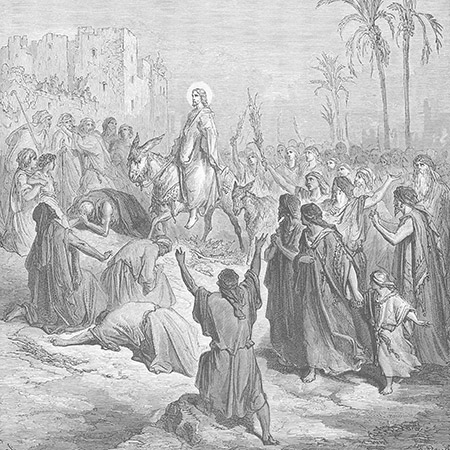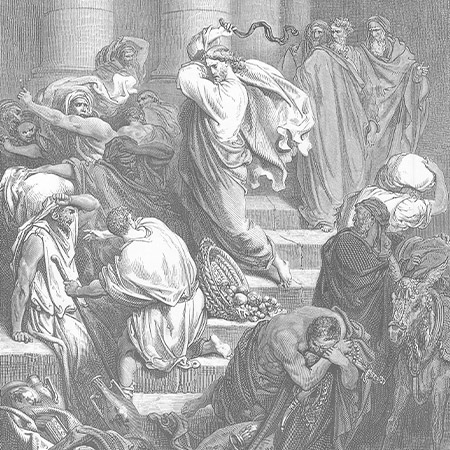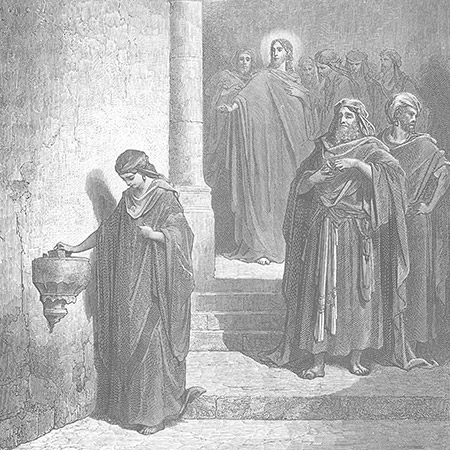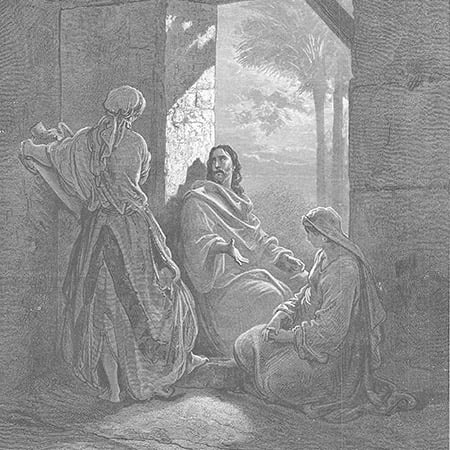The Final Week: A Deconstruction of the Week that Saved the World (Part 1)

Join us in commemorating the final week of Our Blessed Lord’s life on earth by taking a deconstructed look at the most important week in Christianity — the events that saved the world and created new life for us.
Along with sharing a summary of each day of Holy Week, we invite you to jump into the Scriptures to read the accounts in full. Enjoy this look at the who, what, where, when, and why — plus, how we commemorate those events. We hope it helps you drink even more deeply of the coming Easter mystery — the “feast of feasts” and the pinnacle of Holy Week.
Note that this article takes us from Passion Sunday (Palm Sunday) to Silent Wednesday. The Triduum is covered in part two of "The Final Week."
Palm Sunday: By now, Jesus, His disciples, and believers knew the religious authorities were in opposition to Him. After raising Lazarus, Jesus had won over even more believers. Yet, He moves openly, without fear, from Bethany to Jerusalem on the most direct road and riding on a donkey — thus fulfilling the 500-year-old prophecy of Zechariah (9:9-10). A large and enthusiastic crowd of believers shouts out with joy: “Hosanna to the Son of David. Blessed is He who comes in the name of the Lord.” They spread their outer garments and palm branches on the ground before Jesus to pay Him homage in the time-honored way of welcoming kings and heroes.
Modern Day: At the Palm Sunday Mass, the faithful receive palm branches and hold special processions to mark that messianic entry into Jerusalem. The priest, deacon, lectors, and congregation read aloud the Passion narrative during the Gospel.

Holy Monday: This day is often an afterthought of Holy Week, but it shouldn’t be. Jesus’ activity on this day, and on the following ones, is intense. The Master was constantly sought after and the crowds “were hanging on his words” (Luke 19:48).
Monday sets the tone for the next few days. Early in the morning, Jesus and the disciples would go into Jerusalem from Bethany, spend the day teaching in the Temple, and in the evening leave the city, cross the Kidron Valley and stay at the Mount of Olives. The last “great” public act of Christ’s ministry — the Cleansing of the Temple — takes place this day; its significance is underscored by the fact that all four evangelists recorded this event. Turning over the money changing tables, He sweeps clean the “den of thieves” and corrupt practices that have offended God.
Modern Day: Marlon De La Torre, diocesan director of Evangelization and Catechesis, said the start of Holy Week is a great time to also sweep our hearts clean and rid ourselves of distractions.
“What do we do on that Monday, Tuesday, and Wednesday? We should be preparing ourselves to engage Christ through prayer via Sacred Scripture, study via the Catechism of the Catholic Church, and fast, recalling our baptism into Christ’s life and death,” De La Torre said. “Part of our identity with Holy Week is raising the level of our Lenten practice. What are we giving up? What do we take on? What do we embrace? Fasting and a denial of worldly pleasure should be at its highest point right after Passion Sunday because it prepares us for the beauty of the Holy Eucharist on Holy Thursday and sanctifies our hearts to see Christ more clearly on Good Friday.”

Holy Tuesday: Known as the day of “great disputations,” Jesus teaches on the faith and is challenged and questioned by the scribes and Pharisees at seemingly every turn. Our Blessed Lord evades their traps and tells them the parable of the wicked tenants; answers the questions of the tribute to Caesar, the woman with seven husbands, the son of David, and the resurrection; teaches the Greatest Commandment; comments on the widow’s mite; and concludes the debates with a denunciation of the Pharisees and the lament over Jerusalem. He leaves to the Mount of Olives and talks about the coming of the Son of Man. Matthew’s Gospel records Him teaching watchfulness and perseverance through the parable of the 10 virgins.
Modern Day: As on Palm Sunday, the Gospel account of the Passion is read. In the Diocese of Fort Worth, the Chrism Mass is held to consecrate the holy oils used in the sacraments: the Oil of Catechumens (for baptism); the Oil of the Sick (for anointing the ill); and the sacred chrism (for confirmation and holy orders, but also for blessing new altars, churches, and sacred objects).

Silent Wednesday: Scripture is mostly silent on what Jesus and the disciples did this day. Likely, it was on this evening that Mary Magdalene anointed Jesus with expensive perfumed oil in the house of Simon — a foreshadowing of the Passion and a vivid affirmation of Christ’s identity as the Redeemer. After two exhausting days, scholars speculate that Jesus perhaps took this day to spend time with His dear friends Mary, Martha, Lazarus, and the Apostles. Tradition tells us that on this day, Judas agrees to betray Our Lord for 30 pieces of silver (Zechariah prophesies this, too, 11:12-13 ).
